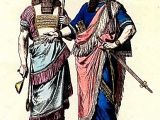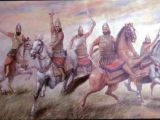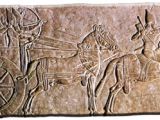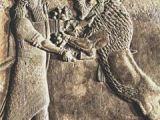Assyrians were one of the most warlike people in history, lovers of the violence of the war and hunt. Amongst the people of the ancient Middle East, they were famous for their cruelty. At the peak of its power, Assyria stretched from Egypt to Persian Gulf. Their aggressiveness was partially attributed to their location: Assyria was in northern Mesopotamia, north of Babylon. As no natural bounders like shores or mountains were found there, they were vulnerable to attacks from any direction. This required the presence of a strong and mobile army.
Assyrians were also good traders, and the main trade routes of Mesopotamia passed through Assyria. Their control was a source of richness.
Like the Babylonians, Assyrians were Akkadians, thus descending from the Semites that during the third millennium BC went out of Arabia and conquered Sumer and Akkad. Assyria emerged around 1900 BC, but it was under the control of the Mitanni kingdom. During this period, Assyrians developed a military tradition and during the 14th century BC, they started their campaigns.
Tukultiapil-Esara I expanded Assyria to the Mediterranean Sea and Black Sea in the 12th century. But their success was fluctuating, due to numerous migrations of people, and the emergence of a new powerful enemy, the Arameans, who were Semites as well. Other main enemies were Egypt and Urartu (later Armenia), which supported the Neo-Hittites. Starting with the 9th century BC, Assyrians turned increasingly cruel. The Assyrian Empire emerged, comprising Mesopotamia and northern Syria. In 745 BC, Tukultiapil Esara III formed a new dynasty and conquered Babylon, Syria and Palestine. In 701 BC, Sin-ahhe-eriba occupied Jerusalem. Ashur-ah-iddina (689-669 BC) invaded Egypt for a short time. Even the Phoenician cities of Tyre and Sidon fell.
Military service was compulsory for all Assyrians, no matter the social class. A body of engineers was created during the 7th century BC, for attacking fortifications. Soon, Assyrians passed from bronze weapons to iron weapons and were amongst the first users of the horse driven war chariots, carrying archers. They were the first people to introduce chivalry units in the army. Heavy chariots were driven by 4 horses and had two pairs of wheels. The crew comprised a driver and an archer. The anterior part was protected by a metal plate.
The power of the infantry was conferred by archers using "composed curb" bow, with high penetration power (the arrow passed bronze armors) and long reach. First, they wore metallic vests, and then they protected themselves with long wooden shields and metal helmets. In direct combat, Assyrians employed axes and short swords. The military commander has triangular scepters, a memory of the heavy war maces used by ancient Mesopotamians. Infantry was helped by chariots and chivalry charges.
Assyrians invented siege machines, like battering rams and mobile towers shooting arrows. The ram hanged on a rope inside the mobile tower. The whole population of the besieged towns would be massacred and the human heads piled outside the city's wall.
In 853 BC, the Assyrian king Shalmaneser III fought an army made of Syrians and Jews joined by the Arabian king Gindibu, with his army of 1,000... camel riders. The Assyrian chivalry was spooked by the sight of the unusual beasts (not known by those times outside Arabia) and ran away. On the ruins of the city of Nineveh (the ancient Assyrian capital), on a relief can be seen the chivalry of King Ashurbanipal (669-627 BC) fighting Arab camel riders (even today, Neo-Assyrians, ones of the few Christians of Iraq, do not consume camel meat).
The richness of Assyria made the import of stone, wood and precious stones possible, which were used for adorning the cities of Ashur, Kalack, Dur-Sarrukin and Nineveh. Royal palaces comprised ornaments depicting winged bulls with human heads, symbolically watching the building. Columns raised for commemorating the victories took pride in the name of the defeated enemy and the number of beheaded or impaled persons. Many bas-reliefs depicted the king killing or mutilating enemies or lions during the hunt. Phoenician made ivory carved plates depicting animals, which adorned the rooms of the palace of Kalack. Rosettes were common elements in the Assyrian art, from diadems to palace decorations. Pottery was well developed, and the works were adorned in vivid colors, having a glassy shine.
Nobles, dignitaries and kings wore large fringed tunics. They all had beards, sometimes curled, and wore a strip encircling their hair. Jewels were made of gold, silver or ivory. Jewelers were usually Phoenicians, and many were deported at the Assyrian court, due to the mass deportations effectuated by the Assyrians.
Average people were allowed to hunt only small game, despite the abundant game in those times. The princes and officials hunted following a well-established protocol: elephants, leopards, aurochs (wild cattle), wild boars, deer, antelopes and onagers (wild asses). Assyrians practiced falconry.
The lion hunting was reserved just for the kings, on foot or in their war chariots on two wheels. Of course, there may have been kings or officials extremely skilled in handling the sword, spear, arrow or lasso. But the royal vanity had to be mesmerized, and this is how the scribes wrote the first ... "hunting tales".
The Assyrian king Tiglatpalasar I (1116-1078 BC) synthesized this way his hunting career: "I killed four giant, powerful bulls in the desert of the Mitanni land, with my hard bow, my steel sword, and my sharp arrows... I also killed 10 strong elephant bulls in Harran on the banks of the Habur River. I captured 4 living elephants. From the order of the Ninurta god, I killed in fight, standing on foot, 120 brave hearted lions and 800 lions from my war chariot."
Ashurnasirpal II (883-859 BC) was more persuasive: in just one hunting party "I killed 30 elephants with the bow, 257 powerful wild bulls I killed from my war chariot, I killed 370 strong lions just by spear like birds in a cage".
Common Assyrians lived in adobe made simple houses. Temples appeared as huge stepped pyramids called ziggurats. The ziggurats were also astronomic observatories. Only priests acceded to the top of the ziggurat, where an altar with a continuously burning flame was located. The priests reported precise astronomic data, eclipse predictions, and changes in the stars' orbits.
The supreme Assyrian god was Ashur (hence the name Assyria), the war god, cruel with the enemies and merciful with his believers. Its symbol was a solar disk. The priest made his prayer lying on his back, accompanied by altar boys. The wife of Ashur was the Babylonian Ninlil, but he also had another goddess. Many foreign gods entered the Assyrian pantheon. Shamshi-Adad I build an altar in Terqa for the Amorite god Dagan. Like in Egypt, the king was the supreme priest and the living representative of the gods and the royalty symbol was the eagle with lion head.
Besides massacring the enemy soldiers, Assyrians made mass deportations of the rulers (nobles, functionaries, craftsmen), so that the remaining people obeyed with humiliation (the most famous is that described in the Bible, of the Israeli to Babylon). Enemy kings were beheaded, and their heads hanged in trees and cities were destroyed. Women were made slaves. This cunning policy, the army and good administration maintained the empire for centuries. The conquered populations had to pay heavy annual tributes.
A body of scribes redacted texts comprising order, laws or commercial documents. Assyrians employed the cuneiform writing, on clay tablets. Most kings and nobles could not write, and engraved their signature on texts using a stone cylinder with their engraved name. By rolling the cylinder seal over the tablet, its characters remained on it.
The expansionism exhausted the power of Assyria, facing continuously new enemies. During Ashurbanipal, Assyria was at its peak, even if it had lost Egypt. But a weak moment appeared in 620 BC, due to a civil war. The attack of the Medes from the East and Babylonians from the south ended with the fall of the capital, Ashur, in 614 BC and Nineveh and Kalack in 612 BC. This time the massacre was perpetrated on the Assyrians, so badly that they were out of history.
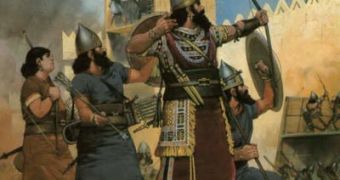
 14 DAY TRIAL //
14 DAY TRIAL // 
